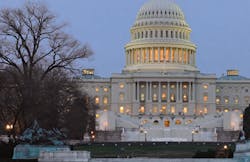NARUC, NASEO Team Releases Microgrid Framework for States
By Kathy Hitchens, Contributing Editor, Microgrid Knowledge
The National Association of Regulatory Utility Commissioners (NARUC) and the National Association of State Energy Officials (NASEO) have released a framework for public utility commissions (PUCs) and state energy offices to use when developing policies, regulations and programs to support microgrids.
The State Microgrid Policy, Programmatic and Regulatory Framework provides background information on microgrids including an overview of the current microgrid landscape, shared PUC and state energy office needs, guidance for stakeholder engagement and technical assistance opportunities, and steps for developing both state microgrid policies and regulations.
The framework also provides examples of real-world microgrid strategies that have been implemented across the country.
“NARUC and NASEO have numerous collaborative efforts bringing together public utility commissions and state energy offices,” said Greg White, executive director of NARUC. “This framework highlights the unique considerations and circumstances affecting the ways in which our diverse state members approach microgrid policies, programs and regulations.”
Microgrids are a key part of the energy transition
A microgrid is a smaller version of the electric power grid that serves a defined area such as a neighborhood, an industrial park or a city’s critical infrastructure. The key feature of a microgrid is its controller, which allows it to disconnect, or island, from the central grid during an outage. The microgrid’s generators and batteries then provide the microgrid’s customers with power until grid power is restored.
This resilience isn’t the only benefit attracting a growing number of businesses, communities, the military, educational institutions and utilities – microgrid demand is on the rise because the technology lowers costs by efficiently managing energy supply and reduces carbon emissions.
Microgrids are Remaking the Energy Landscape: We Want to Hear More
Microgrid 2024: A Revolution in Energy
Microgrids also bolster the central power grid by reducing demand and augmenting grid operations through demand response programs.
In short, microgrids will be a key part of the energy transition because they can mitigate the impact of power outages, facilitate the greater integration of renewables and clean energy into the grid, and encourage localized energy generation.
Modernizing the grid means modernizing energy policies and regulations
Microgrids are changing the fundamental architecture of how the grid is designed and operated, but current energy policies and regulations aren’t necessarily being written with microgrids in mind, according to Cameron Brooks, executive director of Think Microgrid, an education and advocacy organization that is also owned by Microgrid Knowledge’s parent company, Endeavor Business Media.
“The Department of Energy has put forward a vision where microgrids and DER are supplying 30%-50% of the nation’s generation within a decade. That’s an order of magnitude or more from where we are today. So, while microgrids are bringing many customers huge value today, the true potential won’t be realized until we address many of the outdated rules that make, for example, multi-customer and community microgrids illegal today,” Brooks said.
NARUC and NASEO’s goal with the framework is to encourage collaboration among state entities and prepare them for questions they may face while planning and implementing microgrid policies, programs and regulations.
“State energy directors and their staff have policy, program expertise and resources to support microgrid investments and can utilize this framework to learn from their peers and identify pathways for microgrids that align with state resilience, economic and environmental goals,” said David Terry, president of NASEO.
“One of the things that is fundamentally different about microgrids, which this report recognizes, is that they are relevant well beyond the traditional edge of the grid,” Brooks added. “This is about building resiliency at the community level, addressing the increasing impacts of our changing climate and supporting communities that are most vulnerable from inequities of the past.”
The state of the states: Think Microgrid to release state microgrid policy scorecard
This fall, Think Microgrid will be releasing its “2023 Microgrid Policy Scorecard,” the organization’s latest assessment of the state of the states when it comes to microgrid policy.
The scorecard is a follow-up to the organization’s 2022 state assessment, which evaluated each U.S. state’s activities around microgrid deployment, microgrid policy activity, access to grid services markets and policy activities specifically related to resilience and equity. California, Hawaii, New Jersey, New York, Connecticut, Massachusetts and Texas scored as the top states for microgrid policy activity.
